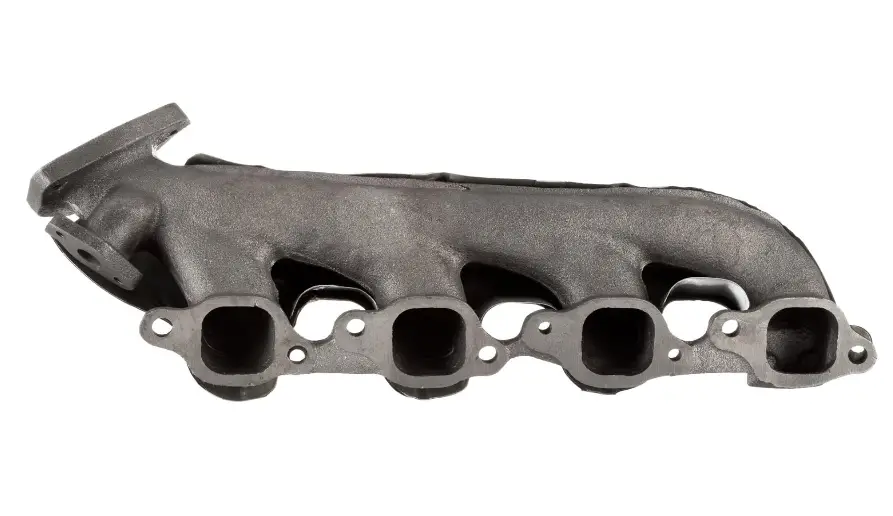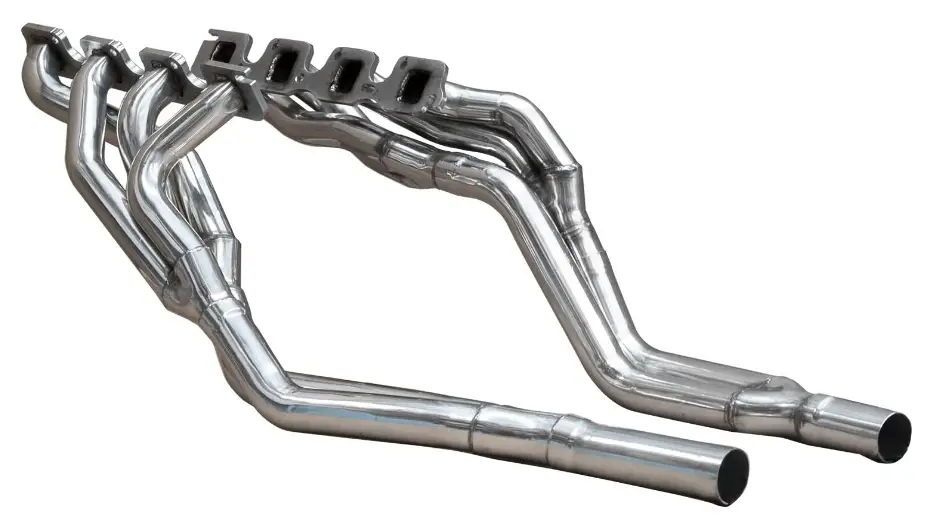The key difference between an exhaust manifold and extractors (headers) lies in performance and design. Exhaust manifolds are typically stock components made of cast iron, prioritizing durability and cost but generating more backpressure. Extractors, or headers, are aftermarket upgrades designed to improve exhaust flow, reduce backpressure, and boost engine performance, making them ideal for enthusiasts seeking more horsepower and efficiency. However, extractors tend to be louder and more expensive.
The exhaust system of a vehicle plays a crucial role in its performance, fuel efficiency, and emissions. Within this system, the exhaust manifold and extractors (also known as headers) are two critical components responsible for directing exhaust gases away from the engine. Although they serve the same basic purpose, they differ significantly in design, function, and performance.
Contents
What Is an Exhaust Manifold?
The exhaust manifold is typically the factory-installed component in most vehicles. It is a cast-iron or stainless-steel part that connects directly to the engine’s exhaust ports. The manifold collects exhaust gases from each of the engine’s cylinders and directs them into a single pipe, which then channels the gases to the catalytic converter and out through the exhaust system.
Key Characteristics of an Exhaust Manifold:
- Material: Usually made from cast iron or sometimes stainless steel for durability.
- Design: Compact and simple, the manifold features short, wide pathways that combine exhaust gases quickly.
- Function: Designed to prioritize cost, durability, and ease of manufacturing, which is why it’s the standard in most stock vehicles.
Advantages of an Exhaust Manifold:
- Durability: Made from cast iron, the manifold can withstand the extreme temperatures of exhaust gases without warping or cracking easily.
- Compact Size: Its simple design makes it easy to install and fit in tight engine bays.
- Cost-Effective: Because it’s mass-produced and made from inexpensive materials, the exhaust manifold is less expensive to manufacture, keeping the overall cost of vehicles lower.
Disadvantages of an Exhaust Manifold:
- Less Performance-Oriented: The exhaust manifold does not optimize the flow of exhaust gases, leading to higher backpressure and lower engine efficiency.
- Heavier: Cast iron is heavy, which can contribute to unnecessary weight in the vehicle.
- Prone to Heat Soak: Since it’s made of cast iron, the manifold retains heat, which can raise engine bay temperatures and affect the overall performance.

What Are Extractors (Headers)?
Extractors, often called headers, are an aftermarket upgrade designed to enhance the efficiency of the exhaust system. They replace the stock exhaust manifold and are made from lightweight materials like stainless steel or ceramic-coated tubing. Unlike the manifold, which quickly merges all the exhaust gases into a single pipe, extractors are designed with individual pipes for each cylinder, which then gradually merge into a single pipe further down the line.
Key Characteristics of Extractors (Headers):
- Material: Made from stainless steel, ceramic, or other high-performance materials.
- Design: Longer, equal-length pipes that are tuned to improve exhaust gas flow from each cylinder.
- Function: Designed to improve exhaust scavenging, reduce backpressure, and enhance engine performance by efficiently removing exhaust gases.
Advantages of Extractors (Headers):
- Improved Performance: Extractors are designed to optimize exhaust flow, reducing backpressure and allowing the engine to breathe more efficiently. This often results in more horsepower and torque.
- Reduced Heat Retention: With materials like stainless steel or ceramic coatings, extractors do not retain as much heat as cast iron manifolds. This helps lower engine bay temperatures and reduces the risk of heat soak.
- Increased Fuel Efficiency: Since the engine doesn’t have to work as hard to expel exhaust gases, extractors can improve fuel efficiency, especially at higher RPMs.
- Weight Reduction: Extractors are typically lighter than cast iron manifolds, contributing to a slight reduction in vehicle weight.
Disadvantages of Extractors (Headers):
- Cost: High-quality extractors are more expensive than stock exhaust manifolds due to their specialized materials and design.
- Complex Installation: Installing extractors can be more complex due to their larger size and longer pipes. In some cases, modifications may be necessary for proper fitment.
- Noise: Extractors can make the exhaust system louder, which may not be desirable for drivers seeking a quieter ride.

Exhaust Manifold vs Extractors
The main difference between exhaust manifolds and extractors is how they affect the flow of exhaust gases from the engine. Extractors are specifically designed to improve this flow, providing better engine performance and efficiency. Let’s take a closer look at how each component performs in various categories:
- Exhaust Flow Efficiency
- Exhaust Manifold: The manifold combines exhaust gases from all cylinders quickly, creating more backpressure in the system. This backpressure can limit the engine’s ability to expel gases efficiently, reducing performance.
- Extractors: Extractors are designed to minimize backpressure by allowing exhaust gases to exit each cylinder through individual pipes. This leads to smoother exhaust flow, enhancing engine power and torque.
- Heat Management
- Exhaust Manifold: Cast iron manifolds are heavy and retain a lot of heat, which can increase the temperature in the engine bay. This heat can cause components in the surrounding area to wear out faster.
- Extractors: Extractors are made from materials that don’t retain as much heat as cast iron. Additionally, ceramic-coated headers can help manage heat even better, keeping engine bay temperatures lower.
- Weight
- Exhaust Manifold: The cast iron construction of the manifold makes it heavy, which can affect the overall weight distribution of the vehicle.
- Extractors: Extractors are typically made from lighter materials, reducing the vehicle’s weight and contributing to better fuel efficiency and handling.
- Cost
- Exhaust Manifold: Stock exhaust manifolds are much cheaper due to their mass production and simple design.
- Extractors: Extractors are more expensive due to the higher-quality materials, performance-oriented design, and sometimes complex installation process.
- Sound
- Exhaust Manifold: The stock manifold tends to mute engine sound, making it quieter.
- Extractors: Extractors often make the exhaust system louder, which may be a desirable trait for performance enthusiasts but can be too loud for some drivers.
Exhaust Manifold vs Extractors: Comparison Table
Here’s a comparison table for Exhaust Manifold vs Extractors –
| Feature | Exhaust Manifold | Extractors (Headers) |
|---|---|---|
| Material | Cast iron or stainless steel | Stainless steel, ceramic, or high-grade steel |
| Design | Compact, short, and wide pathways | Long, equal-length pipes for each cylinder |
| Performance | Prioritizes durability, creates backpressure | Optimized exhaust flow, reduces backpressure |
| Weight | Heavier due to cast iron construction | Lighter materials used |
| Heat Retention | Retains heat, raising engine bay temperature | Less heat retention, often ceramic-coated for better heat management |
| Cost | More affordable, as it’s a stock part | More expensive due to materials and design |
| Sound | Quieter, muffled exhaust note | Louder, aggressive exhaust tone |
| Fuel Efficiency | Average efficiency | Improved fuel efficiency due to optimized exhaust flow |
| Installation | Easier to install, compact design | More complex, may require professional installation |
| Durability | Highly durable, especially in extreme conditions | Durable but may need maintenance for high-performance applications |
When Should You Choose Extractors Over a Manifold?
Upgrading to extractors is a good idea if you’re looking to improve your car’s performance, especially in terms of horsepower and torque. Extractors are ideal for those who:
- Want to increase engine performance and reduce backpressure.
- Are interested in aftermarket modifications for racing or performance driving.
- Are looking to improve fuel efficiency, particularly for long drives or high-RPM performance.
- Want to reduce engine bay heat and overall vehicle weight.
However, if you’re happy with your vehicle’s current performance and don’t want to deal with the added cost or installation complexity, the stock exhaust manifold will suffice for everyday driving needs.
Frequently Asked Questions
Here are some FAQs about exhaust manifolds and extractors –
1. Do extractors (headers) increase horsepower?
Yes, extractors are designed to improve the flow of exhaust gases, which can lead to increased horsepower and torque. The exact gains depend on the vehicle and the design of the extractors, but it’s common to see an improvement in performance.
2. Are extractors better than exhaust manifolds for fuel efficiency?
Yes, extractors can improve fuel efficiency by reducing the engine’s workload. By optimizing exhaust flow and reducing backpressure, the engine can operate more efficiently, especially at higher RPMs.
3. Are extractors louder than exhaust manifolds?
Yes, extractors can make the exhaust system louder because they allow for freer exhaust gas flow, which enhances the engine’s sound. For some, this is an added benefit, but it may be too noisy for those who prefer a quieter ride.
4. Can I install extractors myself, or do I need a professional?
While it’s possible to install extractors yourself, it can be a challenging task due to their size and the need for precise fitment. In some cases, modifications may be required. It’s recommended to have a professional mechanic handle the installation for the best results.
5. Will extractors void my car’s warranty?
In some cases, installing aftermarket parts like extractors can void portions of your car’s warranty, particularly the exhaust system. It’s important to check with your vehicle’s manufacturer or dealership to understand how aftermarket modifications affect your warranty.
Conclusion
Both the exhaust manifold and extractors serve the same purpose of directing exhaust gases away from the engine, but their design and performance differ significantly. The stock exhaust manifold is durable, cost-effective, and compact, making it suitable for everyday driving. However, for those seeking enhanced performance, improved exhaust flow, and better fuel efficiency, upgrading to extractors can provide noticeable benefits.